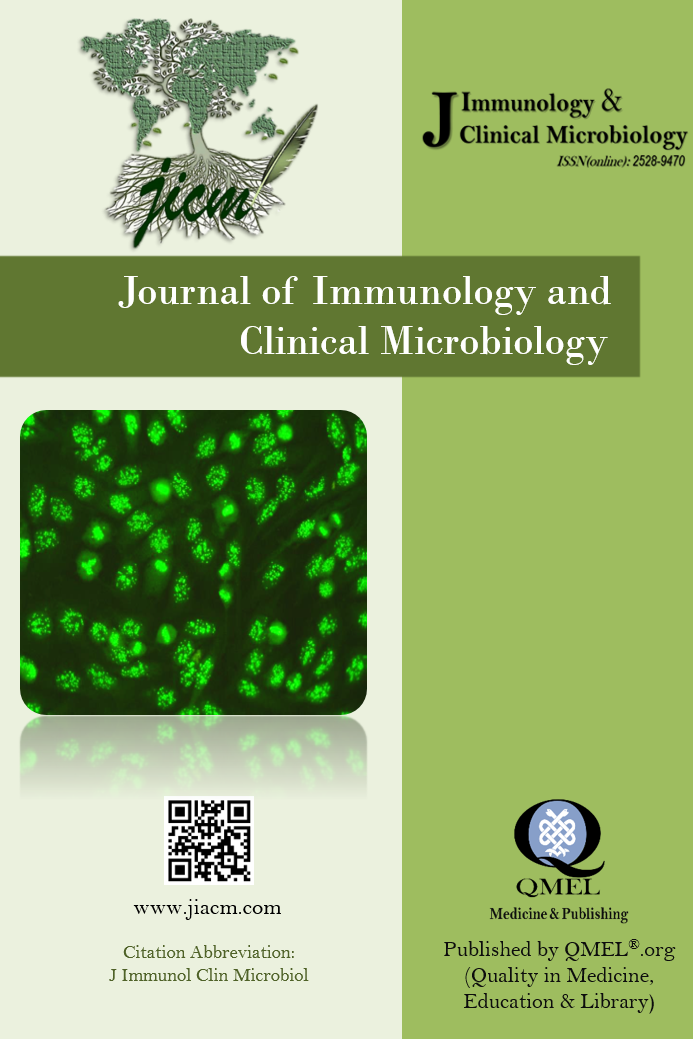Evaluation of Healthcare-Related Candida Infections That Develop in the Medical Intensive Care Unit
Evaluation of Healthcare-Related Candida Infections That Develop in the Medical Intensive Care Unit
Background: The objective of this retrospective study was to evaluate healthcare-related Candida infections and factors related mortality.
Materials and Methods: Patients who were followed-up in the Medical intensive care unit (ICU) between 2015 and 2018 were retrospectively evaluated. Data were obtained by active surveillance method based on patient and laboratory. Statistical analysis of the data was performed using the SPSS 22 package program. The number, percentage, mean ± standard deviation and chi-square (χ²) test were used to analyze the distribution of the data obtained. p
___
- 1.Trilla A. Epidemiology of nosocomial infections in adult intensive care units. Intensive Care Med. 1994; 20: 1-4. 2.Duel G, Fabry J, Nicolle L. Prevention of nosocomialinfection. In: Duel G, Fabry J, Nicolle L, eds. Prevention of hospital-acquired infections. A Practical Guide 2nd ed. Malta: World Health Organization, 2002: 30-8. 3.Dasgupta S, Das S, Chawan NS, Hazra A. Nasocomial infections in the intensive care unit: incidance, risk factors, outcome and associated pathogens in a public tertiary teaching hospital of Eastern India. Indian J Crit Care Med, 2015; 19(1): 14-20. 4. Canela HMS, Cardoso B, Vitali LH, Coelho HC, Martinez R, Ferreira MEDS. Prevalence, virulence factors and antifungal susceptibility of Candida spp. İsolated from bloodstream infections in a tertiary care hospital in Brazil. Mycoses. 2018;61(1):11-21. 5.Ece G, Samlioglu P, Akkoclu G, Atalay S, Kose S. The evaluation of the distribution of yeasts like fungi ‘candida species’ at a tertiary care center in Western Turkey. Int J Med Sci. 2012;9(7):617-20. 6.Caggiano G, Coretti C, Bartolomeo N, Lovero G, De Giglio O, Montagna MT. Candida bloodstream infections in Italy: changing epidemiology during 16 years of surveillance. Biomed Res Int. 2015;2015:256580. 7.Bassetti M, Merelli M, Ansaldi F, de Florentiis D, Sartor A, Scarparo C, Callegari A, Righi E. Clinical and therapeutic aspects of candidemia: a five year single centre study. PLoS ONE. 2015;10:e0127534. 8.Erbay H, Yalcın AN, Serin S, Turgut H, Tomatir E, Cetin B, et al. Nosocomial infections in intensive care unit in a Turkish University Hospital: a 2-years survey. Intensive Care Med, 2003; 29: 1482-8. 9. Kiraz N, Oz Y. Species distribution and in vitro antifungal susceptibility of clinical Candida isolates from university hospital in Turkey over a 5-year period. Med Mycol. 2011;49(2):126-31. 10.Papadimitriou-Olivgeris M, Spiliopoulou A, Fligou F, Spiliopoulou I, Tanaseskou L, Karpetas G, et al. Risk factors and predictors of mortality of candidaemia among critically ill patients: role of antifungal prophylaxis in its development and in selection of non-albicans species. Infection, 2017;45(5):651-7. 11.Yang SP, Chen YY, Hsu HS, Wang FD, Chen LY, Fung CP. A risk factors analysis of healtcare-associated fungal infections in an intensive care unit: A retrospective cohort study. BMC InfectDis, 2013; 13: 10. 12.Etiz P, Kibar F, Ekenoglu Y, Yaman A. Kan kültürlerinden izole edilen Candida türlerinin dağılımı nın ve antifungal duyarlılıklarının retrospektif olarak değerlendirilmesi. ANKEM Derg. 2015;29(3):105-113. 13.Yenigün Koçak B, Kulağlu F, Çelik AD, Akata F. Bir üçüncü basamak hastanesinde erişkin kandidemi olgularının epidemiyolojik özellikleri ve risk faktörlerinin değerlendirilmesi. Mikrobiyol Bul. 2011; 45(3): 489-503. 14. Lindberg E, Hammarström H, Ataollahy N, Kondori N. Species distribution and antifungal susceptibilities of yeasts isolated from the blood samples pf patients with candidemia. Sci Rep. 2019;9(1):3838. 15.Sudan R. Report on the Burden of Endemic Health Care-Associated Infection Worldwide; A Systematic Review of the Literature. World Health Organization, 2011; 1-34. Available from: https://apps.who.int/iris/bitstream/handle/10665/80135/9789241501507_eng.pdf?sequence=1&isAllowed=y (accessed: 17.01.2020).
- 16.Sasso M, Roger C, Sasso M, Poujol H, Barbar S, Lefranrt JY, et al. Changes in the distribution of colonising and infecting Candida spp. isolates, antifungal drug consumption and susceptibility in a French intensive care unit: A 10-years study. Mycoses, 2017; 00: 1-11. 17.Klevens RM, Edwards JR, Richards CL, Horon TL, Gaynes RP, Pollock DA, et al. Estimating health care- associated infections and deaths in U.S. Hospital, 2002. Public Health Rep, 2007; 122(2): 160-6. 18.Horan TC, Andrus M, Dudeck MA. CDC/NHSN surveillance definition of healthcare-associated infection and criteria for specific types of infections in the acute care setting. Am J Infect Control, 2008; 36: 309-32. 19.Adıgüzel N, Karakurt Z, Güngör G, Yazıcıoğlu Ö, Acartürk E, Soğukpınar Ö, et al. Mortality rates and risk factors associated with nosocomial candida infection in a respiratory intensive care unit. Tüberküloz Toraks Derg, 2010; 58(1): 35-43. 20. Wisplinghoff H, Ebbers J, Geurtz L, Stefanik D, Major Y, Edmond M, et al. Nosocomial bloodstream infections due to Candida spp. İn the USA: species distribution, clinical features and antifungal susceptibilities. Int J Antimicrob Agents 2014; 43: 78-81. 21. Arendrup MC, Sulim S, Holm A, Nielsen L, Nielsen SD, Knudsen JD, et al. Diagnostic issues, clinical characteristics, and outcomes for patients with fungemia. J Clin Microbiol 2011; 49: 3300-8.
- Yayın Aralığı: Yılda 4 Sayı
- Başlangıç: 2016
- Yayıncı: Erkan YULA
